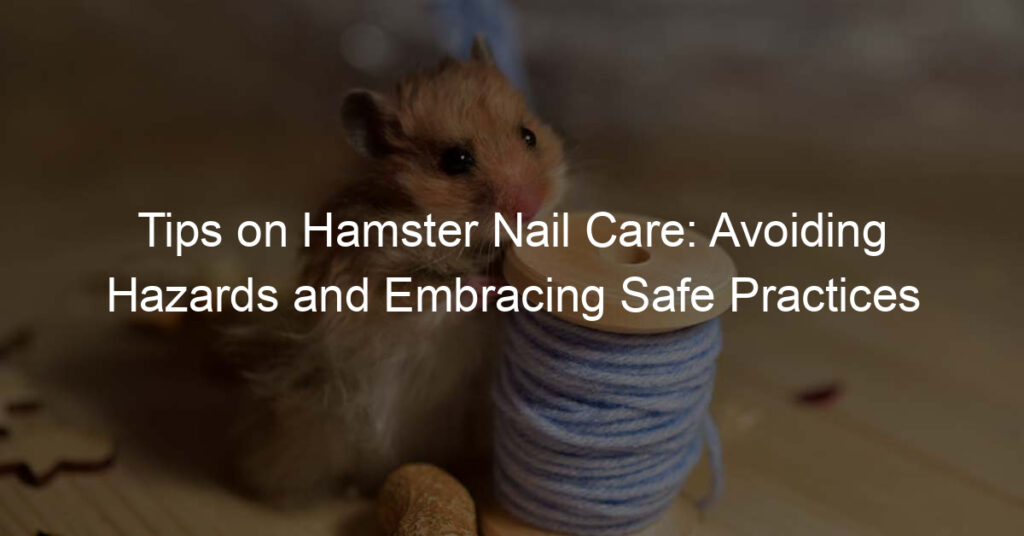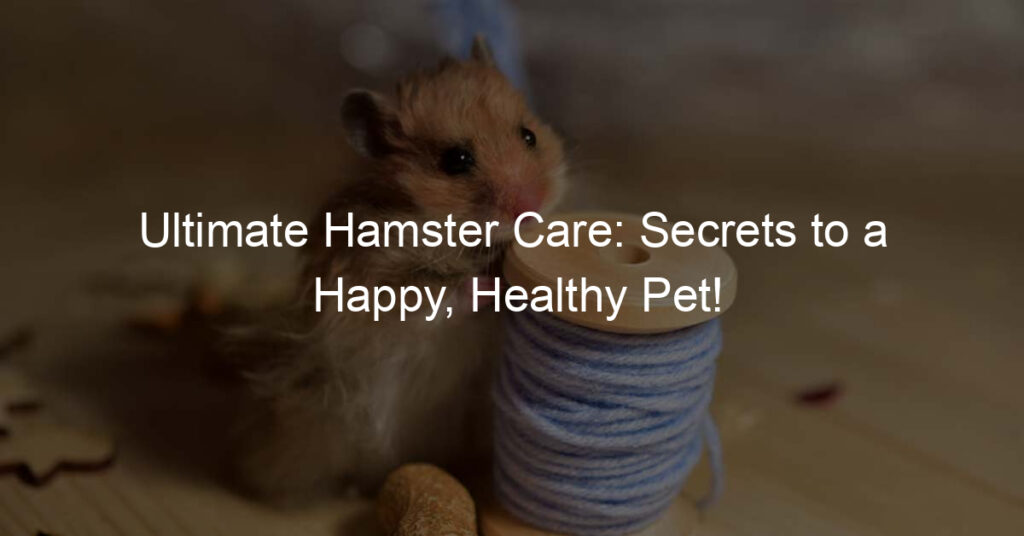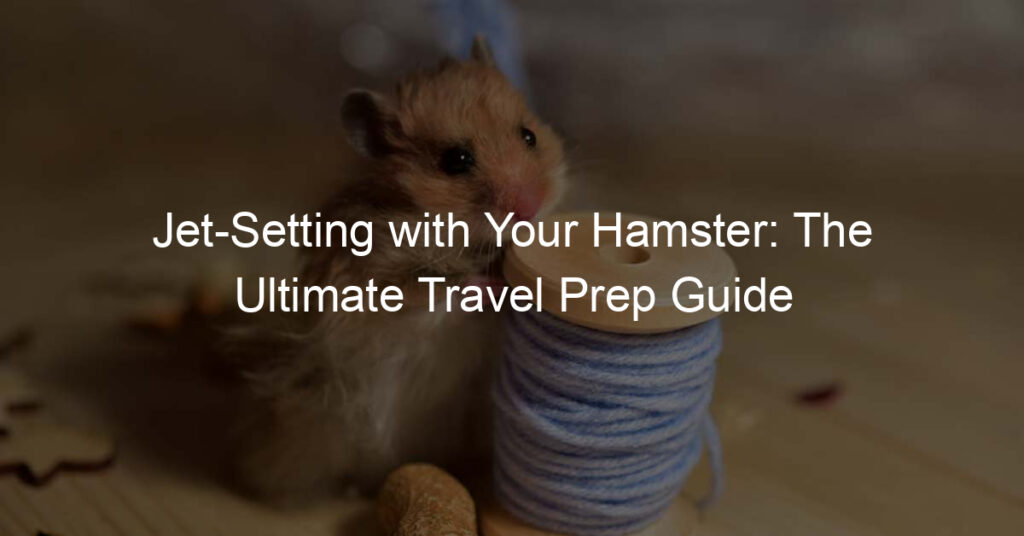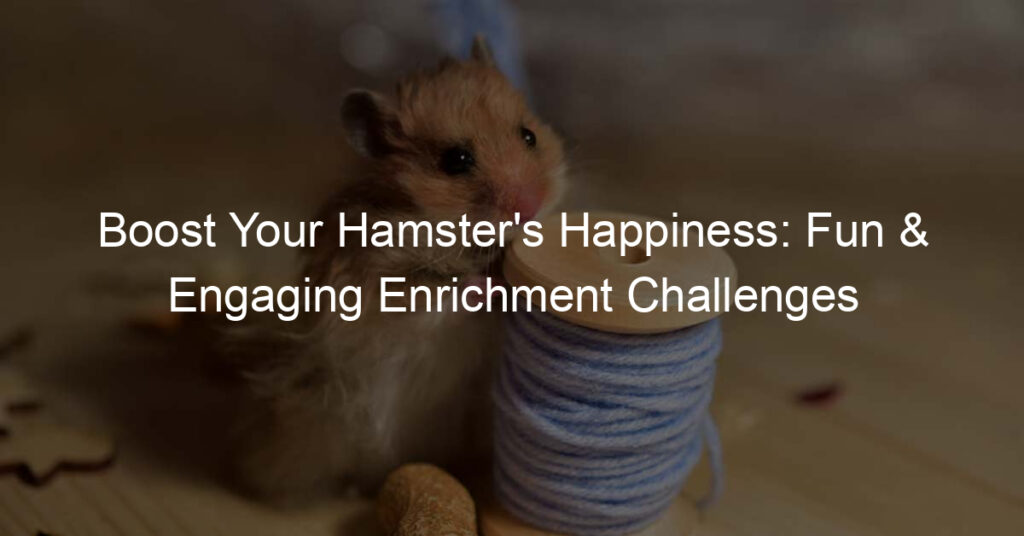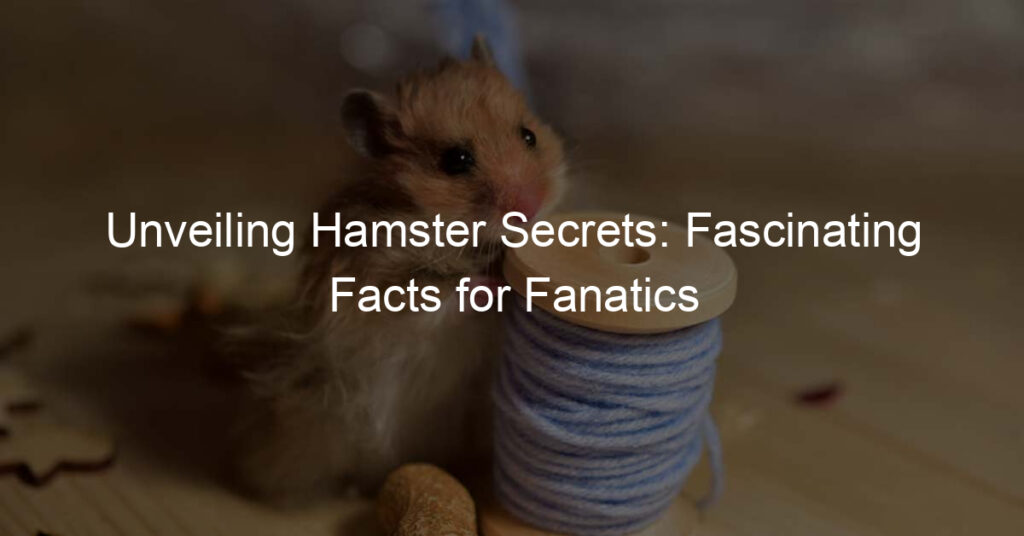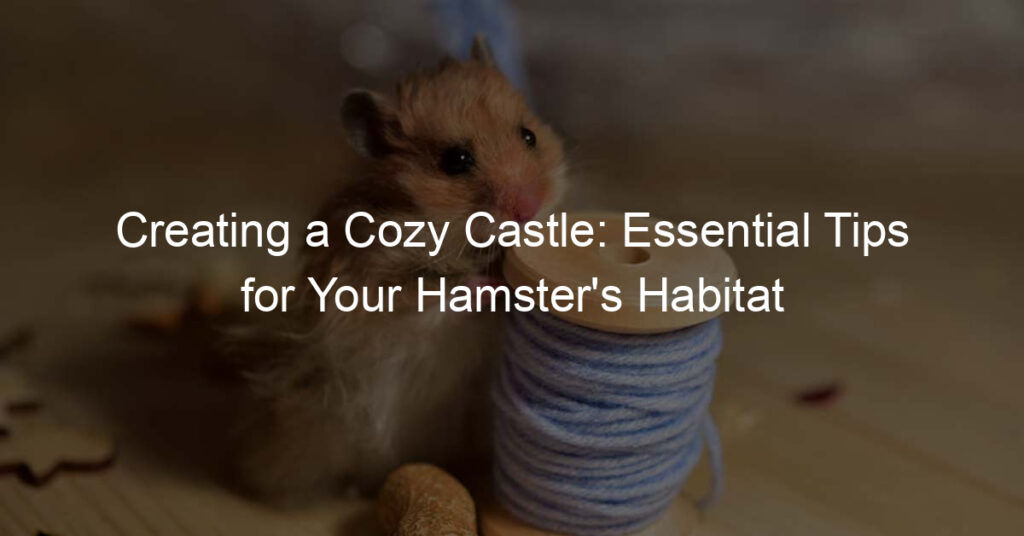Hamster nail care is an essential aspect of maintaining a healthy and happy pet.
As a vital part of their everyday activities, hamster nails are not only used for grabbing food but also for cleaning themselves and gathering nesting materials.
With time, their nails can become sharp, folded inwards, or grow sideways, making it crucial for owners to understand the dangers of overgrown nails and learn safe solutions for their proper care.
Understanding your hamster’s habits and their natural environment is the key to providing appropriate care. This enables you to create a suitable habitat where your pet can maintain its nails through regular grooming and exercise.
Additionally, a proper diet is necessary for maintaining your hamster’s overall health, which directly impacts nail health.
Trimming your hamster’s nails can be challenging because of their size, but with the right tools and techniques, it’s a safe and essential part of their care routine.
Knowing when to consult a veterinarian regarding nail issues is crucial, as it can save your pet from potential discomfort or injury.
Ensuring that you have the necessary supplies and accessories for your hamster’s unique needs can significantly contribute to their well-being.
Key Takeaways
- Hamster nail care is essential for maintaining a healthy and happy pet, as overgrown nails can cause discomfort or injury
- Creating a suitable habitat, providing proper grooming and exercise opportunities, and offering a balanced diet are crucial for your pet’s nail health
- Knowing when to consult a veterinarian and having the right supplies on hand contribute to effective care for your hamster’s nails.
Understanding Hamster Nails
Importance of Proper Nail Care
Hamster nails are essential for these little creatures, as they use them for grabbing food, cleaning themselves, and gathering nesting materials. Therefore, it is important to ensure that your hamster’s nails are well-maintained to keep them healthy and comfortable.
Overgrown nails can pose various issues for hamsters, such as difficulties in walking or climbing and even injuries. Long nails may also curl inwards or sideways, causing discomfort for your hamster.
Hence, taking proper care of your hamster’s nails is crucial for their overall well-being.
Recognizing Overgrown Nails
To identify if your hamster’s nails have grown too long, observe the following signs:
- Difficulty in walking or climbing
- Nails curling inwards or sideways
- Frequent getting caught in the cage or bedding
Prevention is better than cure, so it’s essential to provide an environment that helps maintain the appropriate nail length for your hamster. You can do this by:
- Adding rough-surfaced items, such as slate tiles, terracotta pots, or clean rocks, in high-traffic areas of the enclosure. This encourages your hamster to climb over them and naturally wear down their nails.
- Providing a sand bath or corn cob bedding: These substrates can help with maintaining proper nail length.
Remember to always keep an eye on your hamster’s nails, and if you notice signs of overgrowth, take the necessary steps to trim them safely or consult a professional for help.
Practicing preventive measures and proper nail care will result in a happier, healthier pet hamster.
Hamster Habits and Environments
Understanding Their Behavior
Hamsters are curious, energetic creatures that love to explore their surroundings and engage in various activities. Their natural habitats consist of dry and arid regions—this means they are accustomed to digging, burrowing, and climbing as part of their daily routine.
Understanding these natural behaviors will help you provide a comfortable and stress-free environment for your hamster.
Behavior is closely linked to a hamster’s environment, and any changes in habitat can cause distress. To reduce stress, ensure the cage or aquarium you choose offers enough space for your pet to move around, climb, and play.
Importance of Environment
Environment plays a key role in maintaining a hamster’s overall well-being. Choose a cage or aquarium that’s spacious and provides adequate ventilation, and position it in a room free from drafts.
The ideal location should have a consistent temperature, offering an optimal range of 65-75°F (18-24°C). Humidity levels should also be maintained between 40-60%.
Consider your hamster’s needs for climbing and burrowing while setting up their living space. Incorporate a variety of toys and accessories that encourage them to engage in these natural behaviors.
This might include:
- Climbing: Provide shelves, ladders, and tubes for your hamster to explore and climb.
- Burrowing: Offer at least 2-3 inches of bedding material, such as tissue paper, wood shavings, or shredded cardboard, for your hamster to create their own burrow.
Lastly, remember to combine these elements with a healthy nail care routine, ensuring your hamster’s nails stay trim and safe. By understanding their behavior and optimizing their environment, you’ll promote your furry friend’s overall health and happiness.
Effects of Overgrown Nails
Physical Discomfort
Hamster nails are essential for grabbing food, cleaning themselves, and gathering nesting materials. When a hamster’s nails become too long, they can cause significant physical discomfort.
Overgrown nails can break or curve, leading to pain and infection. The physical discomfort can also manifest as difficulty walking or even limping.
In addition to the pain experienced by the hamster, overgrown nails can lead to unintended harm to their bodies. Impacted nails may force the hamster to constantly scratch or bite their nails, leading to further infections and distress.
Effects on Behavior
The discomfort and pain from overgrown nails can have a direct impact on a hamster’s behavior. Stress and distress may cause a hamster to become more agitated, leading to increased irritability and potentially aggressive behavior.
Long nails may also hinder a hamster’s ability to perform necessary grooming routines, impacting their overall health and well-being. A hamster experiencing pain from overgrown nails may be less inclined to engage in activities like running on a wheel or exploring their cage, further contributing to their stress.
Regularly monitoring and trimming a hamster’s nails is essential for maintaining their health, comfort, and happiness.
By taking proper care of these small creatures, pet owners can prevent unnecessary physical discomfort and behavioral issues arising from overgrown nails.
Appropriate Diet for Nail Health
Balanced Diet
A balanced diet is crucial for maintaining your hamster’s overall health, including nail health. An adequate hamster diet mainly consists of high-quality seeds and pellets combined with fresh fruits and vegetables to provide essential vitamins and minerals.
It’s important to remember that not all seeds and pellets are the same; opt for those specifically designed for hamsters to ensure they receive appropriate nutrition.
Also, keep in mind that hamsters can be prone to obesity, so portion control is crucial to maintaining a happy and healthy hamster.
Key Fruits and Vegetables
Introducing fresh fruits and vegetables into your hamster’s diet can boost their vitamin and mineral intake, supporting health and potentially improving their nail condition. Some fruits and vegetables that are safe to feed your hamster include carrots, broccoli, cucumbers, and apple slices (with seeds removed).
Remember to limit the amount of fresh fruit, as too much sugar can be detrimental to their health.
When feeding fruits and vegetables, make sure to:
- Wash them thoroughly to remove dirt and pesticides.
- Cut them into small, manageable pieces to avoid choking hazards.
- Remove any uneaten fruits and vegetables from the enclosure after a few hours to prevent spoilage.
By providing your hamster with a balanced and nutritious diet, you can help maintain their overall health and contribute to strong, healthy nails.
Proper Grooming and Exercise
Proper Handling
When it comes to grooming and taking care of your hamster, proper handling is essential. Always approach your hamster slowly and calmly to avoid stressing it out.
Make it a habit to wash your hands before and after handling your hamster to avoid transferring germs. Further, try to handle your hamster during its active periods to make it more comfortable.
Exercise and Toys
Regular exercise is crucial for your hamster’s overall health and well-being. Provide your pet with an appropriately sized exercise wheel in its enclosure to ensure it gets enough physical activity.
Choosing a wheel with a solid surface and without gaps is essential for your hamster’s safety.
Apart from the wheel, you can also provide them with various toys and accessories to keep them entertained and mentally stimulated.
Some popular options include:
- Tunnels
- Hideouts
- Climbing structures
- Hamster balls (used under supervision to avoid injury)
Remember to clean these toys regularly to maintain your hamster’s hygiene and prevent the growth of bacteria.
Choosing the Right Bedding
The bedding you choose for your hamster’s habitat is another essential aspect of proper grooming and care. The ideal bedding should be soft, absorbent, and non-toxic to ensure your hamster’s safety and comfort.
Some suitable options include:
- Aspen shavings
- Paper-based bedding
- Coconut fiber bedding
Avoid using cedar or pine shavings, as they can release harmful oils that can irritate your hamster’s respiratory system. Finally, ensure you change the bedding regularly to help maintain a clean and healthy environment for your pet.
Trimming Hamster Nails
Choosing the Right Tools
When it comes to trimming your hamster’s nails, using the appropriate tools is essential. Small animal nail clippers are specifically designed for the delicate nails of hamsters and other small pets.
These clippers will ensure a safe and precise trim. In addition to the nail clippers, it’s important to have styptic powder on hand. This powder can help stop bleeding if you accidentally cut too close to the quick (the blood vessel and nerve inside the nail).
Trimming Process
Trimming your hamster’s nails should be done with care and patience. Start by holding your hamster in a secure yet gentle grip – you can either hold them upright with their paws sticking between your fingers or hold them flat, securing their paws one by one.
Inspect each nail and look for the quick, which is best identified by a pinkish or darker color within the nail.
Clip the nails just beyond the quick, being careful not to cut into it. Trim the nails at a slight angle to maintain a healthy shape. To avoid causing stress or discomfort to your hamster, it is best to work quickly but carefully.
To minimize the risk of injury, trim one nail at a time, making sure your hamster is comfortable and secure before proceeding to the next one. For dwarf hamsters, special attention is required due to their smaller size and more delicate nails.
Handling Accidental Bleeding
Despite your best efforts, accidents can happen, and you might accidentally cut the quick, causing bleeding. In such situations, remain calm and act quickly.
Apply styptic powder to the bleeding nail using a cotton swab or your fingertip. This powder will help stop the bleeding and promote healing.
Keep your hamster in a safe and calm environment while the bleeding stops, and make sure to monitor the nail for any signs of infection in the following days.
Remember, practice makes perfect – the more experience you gain in trimming your hamster’s nails, the more confident and efficient you’ll become.
Just always prioritize your hamster’s safety and comfort during the process.
When to Consult a Veterinarian
It is essential to monitor your hamster’s nails regularly to ensure their overall well-being. However, there may be situations where consulting a veterinarian is necessary. A professional can help assess the condition of your hamster’s nails and provide guidance on the best course of action.
If you notice the nails have become overgrown, it may cause discomfort for your pet. Overgrown nails can curve on themselves and lead to pain, making the hamster unhappy and aggressive.
In worse cases, the nail can grow into the hamster’s paws, posing a risk to their health. Seek a veterinarian’s help as soon as you notice these issues, as they are qualified to trim the overgrown nails safely.
Some hamsters may exhibit signs of discomfort, such as limping or reluctance to walk, due to their nail condition. In such cases, it’s important to consult a veterinarian who can examine the hamster to determine if the issue is nail-related or if there’s an underlying health problem that requires attention.
Apart from trimming nails, a veterinarian can also guide you with proper nail care techniques and prevention tips. This information, coupled with regular home inspection of your hamster’s nails, will help you maintain your pet’s comfort and happiness.
It is crucial to consult a veterinarian if you notice overgrown nails, signs of discomfort, or unexplained changes in your hamster’s behavior. With a professional’s help, you can ensure your hamster stays healthy and comfortable while avoiding any potential complications arising from nail issues.
Buying Supplies and Accessories
When it comes to hamster nail care, having the right supplies and accessories is crucial for ensuring the safety and comfort of your little furry friend. Whether you have a dwarf hamster or a larger variety, maintaining their nails is an important task that requires your attention.
In this section, we’ll cover some of the essential tools and supplies you’ll need to properly care for your hamster’s nails.
First and foremost, you will want to invest in a good pair of nail clippers specifically designed for small animals. You can find these at most pet stores or online.
These clippers are designed to safely and accurately trim your hamster’s nails without causing unnecessary pain or injury. Avoid buying clippers designed for larger animals, as they may be too big and unwieldy for your hamster’s delicate nails.
When setting up your hamster’s living environment, choosing the appropriate bedding is also essential to promote healthy nail growth and maintenance. Avoid using materials that may contain toxic substances or cause injury when your hamster is burrowing or playing.
Kiln-dried pine shavings, for example, are not recommended for hamster bedding due to the potentially harmful substances. Instead, opt for alternative bedding materials like paper-based bedding or aspen shavings.
Toys and exercise equipment like wheels are crucial for your hamster’s overall well-being. Investing in a high-quality wheel can help keep your hamster’s nails trimmed naturally as they run and play.
Ensure that the wheel is an appropriate size for your hamster and does not have any sharp edges or spokes that could harm their nails or feet.
The choice of aquarium or cage for your hamster will also play a role in their nail care. A well-designed cage with proper ventilation, space to explore, and a solid, easy-to-clean surface will provide a comfortable environment for your pet.
Keep in mind that dwarf hamsters may be able to squeeze through the bars of some cages, so choose a housing option with appropriately sized gaps to prevent escape or injury.
Lastly, remember to routinely check your hamster’s nails for signs of overgrowth or any issues that may require attention. Spotting problems early can help prevent discomfort and more serious complications down the road.
Don’t forget to pick up some styptic powder at your local pet store as well, in case of accidental nail trimming mishaps.
Now that you have an idea of the supplies and accessories needed to care for your hamster’s nails, you’re better prepared to create a safe and comfortable environment for your furry companion.
Remember, regular nail maintenance is essential for a happy, healthy hamster.
Proper Care for Different Species
Hamster nail care is essential for your pet’s overall well-being. Different species of hamsters, such as dwarf hamsters and Syrian hamsters, have varying needs when it comes to their environment, stress management, diet, exercise, grooming, and nail care.
It’s crucial to understand these differences to provide the best possible care to your furry friend, regardless of their species.
Dwarf hamsters thrive in environments that mimic their natural habitat, with opportunities to burrow and climb. Providing them with rough surfaces, such as a sand or terracotta dish, can help them wear down their nails naturally.
If they don’t have enough opportunities to wear down their nails, it can lead to discomfort, so be sure to trim their nails regularly with a small nail clipper or have a vet do it for you.
Syrian hamsters, on the other hand, are slightly larger than dwarf hamsters and require more space to move around. Like dwarf hamsters, it’s essential to keep their nails at a comfortable length.
Providing them with an appropriate exercise wheel and rough surfaces to climb on helps maintain their nails and keeps them entertained.
A balanced diet is necessary for all hamster species to maintain their health and prevent stress. Ensure that your hamster has access to fresh water and high-quality rodent food pellets, along with an occasional treat of fruits and vegetables.
Diet can also play a role in maintaining strong nails, so be sure your hamster receives adequate nutrition.
Stress management is essential for all hamsters, as it can affect their overall health and cause their nails to become brittle and prone to breakage. Make sure to provide them with hiding spots and minimize handling, especially for more sensitive dwarf hamster species.
Grooming is vital for maintaining the health of your pet’s nails. Regularly trim their nails to prevent them from becoming too long and causing discomfort. Also, brush your hamster’s coat, especially in long-haired breeds, to prevent any mats or tangles.
If you’re unsure about how to groom your hamster properly, consult a veterinarian or professional groomer for guidance.
Finally, proper nail care is imperative for all hamster species. Keep an eye on their nails regularly and ensure they are not overgrown, abnormal in appearance, or causing discomfort for your hamster.
When needed, trim their nails or seek professional assistance from a veterinarian to avoid any potential complications. By attending to these various aspects of hamster care, you’ll help ensure your pet lives a happy, healthy life, no matter their species.
Conclusion
Hamster nail care is essential for maintaining the well-being of your furry friend. Just like humans, hamster nails never stop growing, so it is important to monitor their length and condition.
Overgrown nails can become curved and pierce the hamster’s paws, causing pain and discomfort.
To maintain your hamster’s nails, prevention is key. Hamsters often keep their nails short by scratching at objects in their environment. Nevertheless, if you notice that their nails have become too long, it might be time for a trim.
Make sure to gather the necessary supplies, such as small animal nail clippers and styptic powder, which help stop bleeding if you accidentally cut too close to the quick of the nail.
When trimming your hamster’s nails, hold them gently but securely. Carefully clip each nail, avoiding the quick. Be mindful that not all hamsters need regular nail trimming, as many manage their nail length on their own.
Observe your hamster’s nails and their behavior to determine the best approach for their nail care.
Remember that the safety and well-being of your hamster is the primary goal of nail care. By keeping these tips in mind and performing careful and regular maintenance, you can ensure that your hamster remains happy, healthy, and comfortable.
Frequently Asked Questions
How can I safely trim my hamster’s nails?
To safely trim your hamster’s nails, follow these steps:
- Gather the necessary tools, such as small animal nail clippers, a towel, and a styptic powder in case of bleeding.
- Gently wrap your hamster in the towel to restrain it and expose its paws.
- Hold your hamster’s paw firmly but gently, and ensure the nails are separated.
- Carefully trim each nail, avoiding the quick (the pink part that contains blood vessels).
- Use styptic powder if bleeding occurs.
- Make sure to reward your hamster with a treat after trimming its nails.
What signs indicate that my hamster’s nails are too long?
Signs indicating that your hamster’s nails are too long include difficulty walking, scratching, discomfort, and curved nails. If you notice any of these signs, it’s time for a trim.
What causes hamster nails to curl, and how can I fix it?
Curled hamster nails are usually caused by neglecting regular nail trims, resulting in overgrown nails. To fix curled nails, carefully trim the overgrown nails by following the steps mentioned in the first question.
Regular nail trimming can help prevent this issue in the future.
Are there alternatives to trimming for hamster nail care?
Some alternatives to trimming hamster nails include providing rough surfaces or stones in the cage for them to walk and naturally file their nails. However, using these methods may not be sufficient in maintaining the ideal nail length, and regular nail trimming may still be necessary.
What’s the ideal hamster nail length?
The ideal hamster nail length is one where the nails don’t touch the surface when their paws are flat. This helps avoid discomfort and ensures the hamster can walk easily without any issues.
Regular inspections and nail trims will help maintain the ideal nail length for your hamster.
Can sandpaper be used for maintaining hamster nails?
While sandpaper can help file down and maintain hamster nails, it’s not recommended due to the risk of causing discomfort or injury to their delicate paws. It’s better to use safer alternatives like trimming their nails with proper tools or providing natural surfaces within their cage for them to wear down their nails.

